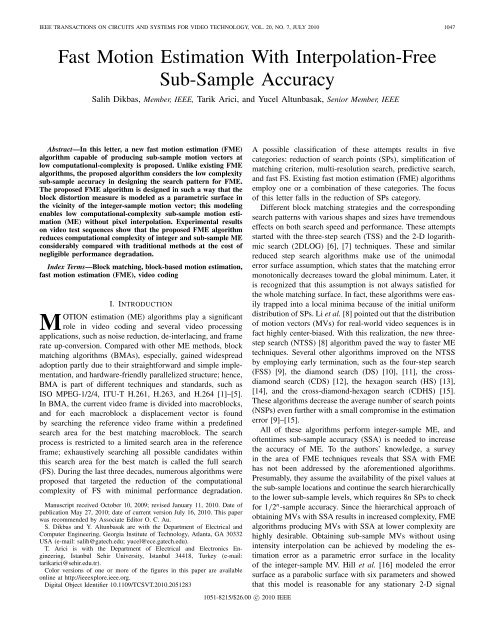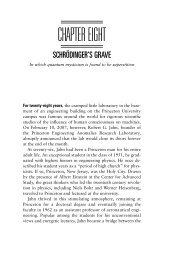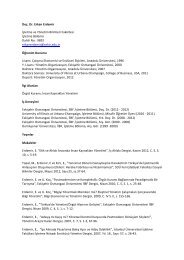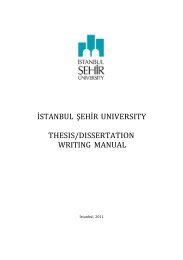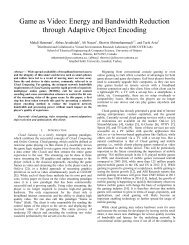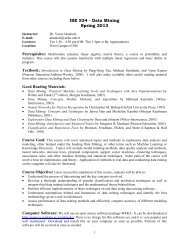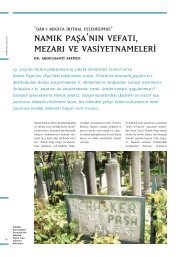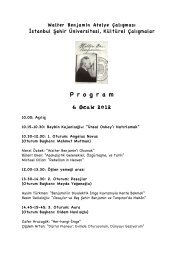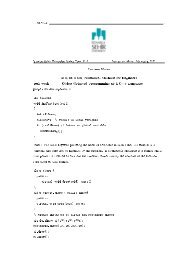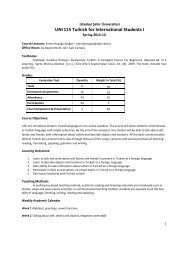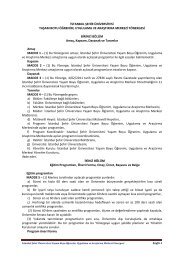Fast Motion Estimation With Interpolation-Free Sub ... - IEEE Xplore
Fast Motion Estimation With Interpolation-Free Sub ... - IEEE Xplore
Fast Motion Estimation With Interpolation-Free Sub ... - IEEE Xplore
You also want an ePaper? Increase the reach of your titles
YUMPU automatically turns print PDFs into web optimized ePapers that Google loves.
<strong>IEEE</strong> TRANSACTIONS ON CIRCUITS AND SYSTEMS FOR VIDEO TECHNOLOGY, VOL. 20, NO. 7, JULY 2010 1047<br />
<strong>Fast</strong> <strong>Motion</strong> <strong>Estimation</strong> <strong>With</strong> <strong>Interpolation</strong>-<strong>Free</strong><br />
<strong>Sub</strong>-Sample Accuracy<br />
Salih Dikbas, Member, <strong>IEEE</strong>, Tarik Arici, and Yucel Altunbasak, Senior Member, <strong>IEEE</strong><br />
Abstract—In this letter, a new fast motion estimation (FME)<br />
algorithm capable of producing sub-sample motion vectors at<br />
low computational-complexity is proposed. Unlike existing FME<br />
algorithms, the proposed algorithm considers the low complexity<br />
sub-sample accuracy in designing the search pattern for FME.<br />
The proposed FME algorithm is designed in such a way that the<br />
block distortion measure is modeled as a parametric surface in<br />
the vicinity of the integer-sample motion vector; this modeling<br />
enables low computational-complexity sub-sample motion estimation<br />
(ME) without pixel interpolation. Experimental results<br />
on video test sequences show that the proposed FME algorithm<br />
reduces computational complexity of integer and sub-sample ME<br />
considerably compared with traditional methods at the cost of<br />
negligible performance degradation.<br />
Index Terms—Block matching, block-based motion estimation,<br />
fast motion estimation (FME), video coding<br />
I. Introduction<br />
MOTION estimation (ME) algorithms play a significant<br />
role in video coding and several video processing<br />
applications, such as noise reduction, de-interlacing, and frame<br />
rate up-conversion. Compared with other ME methods, block<br />
matching algorithms (BMAs), especially, gained widespread<br />
adoption partly due to their straightforward and simple implementation,<br />
and hardware-friendly parallelized structure; hence,<br />
BMA is part of different techniques and standards, such as<br />
ISO MPEG-1/2/4, ITU-T H.261, H.263, and H.264 [1]–[5].<br />
In BMA, the current video frame is divided into macroblocks,<br />
and for each macroblock a displacement vector is found<br />
by searching the reference video frame within a predefined<br />
search area for the best matching macroblock. The search<br />
process is restricted to a limited search area in the reference<br />
frame; exhaustively searching all possible candidates within<br />
this search area for the best match is called the full search<br />
(FS). During the last three decades, numerous algorithms were<br />
proposed that targeted the reduction of the computational<br />
complexity of FS with minimal performance degradation.<br />
Manuscript received October 10, 2009; revised January 11, 2010. Date of<br />
publication May 27, 2010; date of current version July 16, 2010. This paper<br />
was recommended by Associate Editor O. C. Au.<br />
S. Dikbas and Y. Altunbasak are with the Department of Electrical and<br />
Computer Engineering, Georgia Institute of Technology, Atlanta, GA 30332<br />
USA (e-mail: salih@gatech.edu; yucel@ece.gatech.edu).<br />
T. Arici is with the Department of Electrical and Electronics Engineering,<br />
Istanbul Sehir University, Istanbul 34418, Turkey (e-mail:<br />
tarikarici@sehir.edu.tr).<br />
Color versions of one or more of the figures in this paper are available<br />
online at http://ieeexplore.ieee.org.<br />
Digital Object Identifier 10.1109/TCSVT.2010.2051283<br />
1051-8215/$26.00 c○ 2010 <strong>IEEE</strong><br />
A possible classification of these attempts results in five<br />
categories: reduction of search points (SPs), simplification of<br />
matching criterion, multi-resolution search, predictive search,<br />
and fast FS. Existing fast motion estimation (FME) algorithms<br />
employ one or a combination of these categories. The focus<br />
of this letter falls in the reduction of SPs category.<br />
Different block matching strategies and the corresponding<br />
search patterns with various shapes and sizes have tremendous<br />
effects on both search speed and performance. These attempts<br />
started with the three-step search (TSS) and the 2-D logarithmic<br />
search (2DLOG) [6], [7] techniques. These and similar<br />
reduced step search algorithms make use of the unimodal<br />
error surface assumption, which states that the matching error<br />
monotonically decreases toward the global minimum. Later, it<br />
is recognized that this assumption is not always satisfied for<br />
the whole matching surface. In fact, these algorithms were easily<br />
trapped into a local minima because of the initial uniform<br />
distribution of SPs. Li et al. [8] pointed out that the distribution<br />
of motion vectors (MVs) for real-world video sequences is in<br />
fact highly center-biased. <strong>With</strong> this realization, the new threestep<br />
search (NTSS) [8] algorithm paved the way to faster ME<br />
techniques. Several other algorithms improved on the NTSS<br />
by employing early termination, such as the four-step search<br />
(FSS) [9], the diamond search (DS) [10], [11], the crossdiamond<br />
search (CDS) [12], the hexagon search (HS) [13],<br />
[14], and the cross-diamond-hexagon search (CDHS) [15].<br />
These algorithms decrease the average number of search points<br />
(NSPs) even further with a small compromise in the estimation<br />
error [9]–[15].<br />
All of these algorithms perform integer-sample ME, and<br />
oftentimes sub-sample accuracy (SSA) is needed to increase<br />
the accuracy of ME. To the authors’ knowledge, a survey<br />
in the area of FME techniques reveals that SSA with FME<br />
has not been addressed by the aforementioned algorithms.<br />
Presumably, they assume the availability of the pixel values at<br />
the sub-sample locations and continue the search hierarchically<br />
to the lower sub-sample levels, which requires 8n SPs to check<br />
for 1/2 n -sample accuracy. Since the hierarchical approach of<br />
obtaining MVs with SSA results in increased complexity, FME<br />
algorithms producing MVs with SSA at lower complexity are<br />
highly desirable. Obtaining sub-sample MVs without using<br />
intensity interpolation can be achieved by modeling the estimation<br />
error as a parametric error surface in the locality<br />
of the integer-sample MV. Hill et al. [16] modeled the error<br />
surface as a parabolic surface with six parameters and showed<br />
that this model is reasonable for any stationary 2-D signal
1048 <strong>IEEE</strong> TRANSACTIONS ON CIRCUITS AND SYSTEMS FOR VIDEO TECHNOLOGY, VOL. 20, NO. 7, JULY 2010<br />
and extremely close to the actual interpolation surface for<br />
sources with Gaussian-shaped autocorrelation functions. The<br />
method assumes that the block distortion measure (BDM) at<br />
the integer-sample MV point and its 8-neighbors are known.<br />
Hence, it can only be applied to the FS, TSS, FSS, and<br />
DS out of the aforementioned algorithms. It is clear that the<br />
reduction of SPs for integer-sample ME and sub-sample ME<br />
are decoupled for most of the FME algorithms in the literature.<br />
In this letter, we propose a FME algorithm that considers SP<br />
reduction for both integer-sample ME and sub-sample ME<br />
simultaneously. The proposed method can produce MVs with<br />
SSA through FME and without using intensity interpolation<br />
for sub-sample ME.<br />
The rest of this letter is organized as follows. In Section II,<br />
the proposed integer-sample FME algorithm is presented; in<br />
the rest of the letter this method will be referred to as the 8-<br />
neighbor search (ENS) algorithm. Then, in Section III, SSA is<br />
reviewed and a modification is presented. Experimental results<br />
and discussion are presented in Section IV. Finally, Section V<br />
concludes the letter.<br />
II. 8-Neighbor Search Algorithm<br />
Although the ENS algorithm has no restriction on search<br />
window size similar to DS, CDS, and HS, a search window<br />
of w = ±7 with a block size of B × B is considered here for<br />
easier explanation and comparison with other FME algorithms.<br />
The goal is not only to reduce the average NSPs of integersample<br />
ME but also to ensure that the BDM of the integersample<br />
MV point along with its 8-neighbors are calculated so<br />
that the subsequent interpolation-free SSA model can be used<br />
successfully. In this section, an integer-sample FME algorithm<br />
achieving this purpose is presented. For ease of explanation,<br />
the set of n-pixels away 8-neighbors is defined as<br />
N n 8<br />
= {(x, y)|x = −n, 0,n; y = −n, 0,n}\{(0, 0)} (1)<br />
where (x, y) denotes the rectangular coordinates relative to the<br />
location of a pixel of interest. Clearly, N8<br />
n for n = 1 gives the<br />
immediate 8-neighbors of a pixel of interest.<br />
The details of the ENS algorithm for a search window of<br />
w = ±7 are as follows.<br />
Step 1) Points in N8<br />
1 ∪{(0, 0)} of the search center are<br />
checked, and the minimum BDM point is found.<br />
Then, the remaining N8<br />
1 of the minimum BDM<br />
point are checked. If the minimum BDM point is the<br />
search center, the search is stopped, i.e., MV=(0, 0).<br />
Otherwise, go to Step 2.<br />
Step 2) Points in N8<br />
3 of the search center are checked. If<br />
the minimum BDM point is the search center, the<br />
search is stopped, i.e., MV=(0, 0). Otherwise, go to<br />
Step 3.<br />
Step 3) Check the remaining N8<br />
3 of the minimum BDM<br />
point. Update the minimum BDM point. Check the<br />
N8<br />
1 of the minimum BDM point.<br />
Finally, the point giving the minimum BDM is declared as the<br />
integer-sample MV for this block.<br />
Fig. 1. (a) 4–2–1 step-size illustration. (b) 3–3–1 step-size illustration.<br />
(c) Illustration of the integer-sample MV point and its 8-neighbors. In (a)<br />
and (b), the light-blue shaded area indicates the potential reachable SPs in the<br />
second stage.<br />
The proposed method selects the step sizes more prudently<br />
compared with TSS, NTSS, and other similar algorithms. They<br />
check N8 4 first; then, N 8 2 of the minimum BDM point; finally,<br />
N8<br />
1 of the minimum BDM point. Hence, the step sizes of<br />
these algorithms are 4–2–1, whereas, the proposed algorithm<br />
uses 3–3–1, instead. The approach taken by these methods<br />
decreases the size of the possible reachable area faster than<br />
the proposed method. As can be observed from Fig. 1, the<br />
number of possible reachable points by TSS at each step are<br />
15 2 → 7 2 → 3 2 , whereas for the proposed algorithm they<br />
are 15 2 → 9 2 → 3 2 ; the reachable points at the second step<br />
are shown with a light-blue shade in the figure. Compared<br />
with TSS, the first step size gives a more center-biased nature<br />
and the second step size offers a larger reachable area to the<br />
proposed algorithm.<br />
III. <strong>Sub</strong>-Sample Accuracy <strong>With</strong>out <strong>Interpolation</strong><br />
In applications employing ME, oftentimes integer-sample<br />
MV is not sufficient to achieve the desired quality level;<br />
hence, integer-sample ME is followed by sub-sample ME<br />
for improvement. SSA improves the quality substantially at<br />
the cost of increased complexity; sub-sample ME constitutes<br />
a significant amount of the overall computational complexity<br />
[18]. As a result, a coarse-to-fine manner is used to refine<br />
the accuracy of the MV. First, the coarse MV is found by<br />
integer-sample ME. Then, refinement can be achieved by two<br />
different approaches: 1) direct interpolation of the reference<br />
frame followed by sub-sample ME, or 2) 2-D polynomial<br />
surface modeling of the BDM in the vicinity of the integersample<br />
MV.<br />
For the first method, refinement is usually achieved as<br />
follows: 1) interpolate the reference frame search area at subsample<br />
locations, and 2) perform sub-sample ME around the<br />
coarse MV. Evidently, there will be repeated interpolation of<br />
some of the pixel neighborhoods since the search area of<br />
different blocks may overlap. One alternative to this approach<br />
is to precompute the sub-sample location data for the entire<br />
frame; however, this results in increased memory requirements.<br />
Using short-length interpolating filters and employing<br />
sub-sample ME in a hierarchical fashion in the vicinity of<br />
the selected integer-sample MV are among the common techniques<br />
used to decrease the complexity of the sub-sample ME.<br />
Regardless of how the sub-sample data is obtained, additional<br />
8n SPs are checked for 1/2 n -sample accuracy in hierarchical
DIKBAS et al.: FAST MOTION ESTIMATION WITH INTERPOLATION-FREE SUB-SAMPLE ACCURACY 1049<br />
sub-sample ME approach. Hence, real-time application use of<br />
this method becomes harder to justify because of its increased<br />
computational complexity.<br />
For the second method, refinement is achieved by modeling<br />
the BDM values in the vicinity of the integer-sample MV as a<br />
2-D polynomial surface. There are different estimation models<br />
and methods. <strong>Estimation</strong> models range from using integersample<br />
MV point along with its 4-neighbors to 8-neighbors,<br />
which gives rise to 2-D polynomial surface models having a<br />
different number of parameters. In the next section, we give<br />
the details of such a model.<br />
A. Parabolic Model<br />
Hill et al. [16] use a parametrically controlled parabolic surface<br />
model that was originally suggested by Giunta et al. [19]<br />
as<br />
f (x, y) =p 2,0 x 2 + p 1,1 xy + p 0,2 y 2 + p 1,0 x + p 0,1 y + p 0,0 (2)<br />
where f is the estimated BDM value of a block, and x, y ∈<br />
[−1, 1] are the coordinates of the estimation centered at<br />
the integer-sample MV of that block. BDM values of the<br />
integer-sample MV and its 8-neighbors, locations of which<br />
are illustrated in Fig. 1(c), are used to obtain the model<br />
parameters. Then, estimated BDM values at sub-sample locations<br />
can be easily calculated using (2), and the location<br />
giving the minimum value can be found using a heuristic or<br />
gradient search type algorithm. Hill et al. [16] discuss solution<br />
methods ranging from underdetermined to overdetermined<br />
models for the solution of (2) at given nine points, and propose<br />
a model called CSM, which is superior to overdetermined and<br />
underdetermined models. CSM uses the integer-sample MV,<br />
its 4-neighbors, and one of the diagonal neighbors. Although<br />
CSM gives better results compared with overdetermined and<br />
underdetermined models, they are clearly discarding three data<br />
points.<br />
It is known by the Stone–Weierstrass theorem [20], [21]<br />
that any 2-D continuous function defined on a closed interval<br />
can be uniformly approximated by a polynomial with two<br />
variables. In addition, sub-sample maps at 1/8-accuracy presented<br />
by Chiew et al. [17] suggest that the quality of the<br />
approximation can be improved. Hence, a new model with<br />
more parameters can be used to better employ these three<br />
discarded data points.<br />
The model proposed in (2) can be seen as a second-order<br />
bivariate Taylor polynomial approximation as well. The order<br />
can be increased to three to offer more flexibility, as the second<br />
derivative will not necessarily evaluate to zero, hence allowing<br />
variation across the surface. Increasing the order to three<br />
improves the accuracy of the approximation by adding the<br />
monomials {x 3 ,x 2 y, xy 2 ,y 3 }. In the next section, the proposed<br />
method to obtain the coefficients of this bivariate polynomial<br />
is presented.<br />
B. Parameter <strong>Estimation</strong><br />
The proposed polynomial approximation has ten unknown<br />
parameters, whereas only nine data points are available. To<br />
better explain the monomial selection for the given data points<br />
we express the Taylor polynomial approximation in matrix<br />
form as<br />
f (x, y) =m T p (3)<br />
where m is the monomial vector described as<br />
m =[m 0 ,m 1 ,...,m r−1 ] T<br />
=[x 0 y 0 ,x 1 y 0 ,x 0 y 1 ,...,x d y 0 ,x d−1 y 1 ,...,x 1 y d−1 ,x 0 y d ] T<br />
and p is the parameter vector defined as<br />
p =[p 0,0 ,p 1,0 ,p 0,1 ,... ,p d,0 ,p d−1,1 ,... ,p 1,d−1 ,p 0,d ] T<br />
r =(n + 1)(n +2)/2 is the number of monomials, and d is the<br />
order of Taylor approximation.<br />
Evaluating (3) at given nine points gives the following<br />
system of equations:<br />
f =[m 0 |m 1 |···|m 8 ] T p = Mp (4)<br />
where m j refers to the monomial vector evaluated at point j.<br />
M can be viewed as a matrix of columns as well, where each<br />
column corresponds to a monomial evaluated at nine points. To<br />
have a unique solution, the columns of M have to be linearly<br />
independent. It is observed that for given sampled values,<br />
columns of M corresponding to monomials {x 3 ,y 3 } are the<br />
same as the columns of M corresponding to monomials {x, y},<br />
respectively. To have a nonsingular M T M matrix, we need to<br />
remove monomials {x 3 ,y 3 } and add one more monomial from<br />
the additional monomials of the fourth-order approximation<br />
terms, {x 4 ,x 3 y, x 2 y 2 ,xy 3 ,y 4 }. It can be easily observed that<br />
only the x 2 y 2 term gives a unique solution since the other<br />
columns corresponding to terms {x 4 ,x 3 y, xy 3 ,y 4 } are the<br />
same as columns corresponding to the terms {x 2 ,xy,xy,y 4 },<br />
respectively. Although monomials are linearly independent, for<br />
the given nine data points some monomials give the same<br />
values at these points, e.g., x and x 3 , x 2 and x 4 , xy and x 3 y.<br />
Hence, the monomials {1,x,y,x 2 , xy, y 2 ,x 2 y, xy 2 ,x 2 y 2 } are<br />
used to have a unique solution using the specified nine data<br />
points. In this case, the solution is<br />
p 2,2 = f 4 − 1 2 (f 3 + f 5 + f 1 + f 7 )+ 1 4 (f 2 + f 6 + f 0 + f 8 )<br />
p 1,2 = 1 2 (f 3 − f 5 )+ 1 4 (f 2 − f 6 )+ 1 4 (f 8 − f 0 )<br />
p 2,1 = 1 4 (f 6 − f 2 )+ 1 2 (f 1 − f 7 )+ 1 4 (f 8 − f 0 )<br />
p 0,2 = −f 4 + 1 2 (f 1 + f 7 )<br />
p 1,1 = 1 4 (f 8 + f 0 ) − 1 4 (f 6 + f 2 )<br />
p 2,0 = −f 4 + 1 2 (f 3 + f 5 )<br />
p 0,1 = 1 2 (f 7 − f 1 )<br />
p 1,0 = 1 2 (f 5 − f 3 )<br />
p 0,0 = f 4 . (5)<br />
Comparing the CSM solution and (5) reveals that the<br />
proposed polynomial approximation gives the same answer as
1050 <strong>IEEE</strong> TRANSACTIONS ON CIRCUITS AND SYSTEMS FOR VIDEO TECHNOLOGY, VOL. 20, NO. 7, JULY 2010<br />
CSM for parameters p 2,0 ,p 0,2 ,p 1,0 ,p 0,1 , and p 0,0 . Since all<br />
nine data points are used, the p 1,1 term is calculated directly.<br />
Besides, the accuracy is improved due to the additional terms<br />
p 2,1 ,p 1,2 ,p 2,2 . Unlike the CSM solution, the solution (5) does<br />
not require minimization of a cost function to select p 1,1 term;<br />
as a result, it saves 12 function evaluations. Also, it is easily<br />
obtained by addition and bit shift operations.<br />
IV. Experimental Results and Discussion<br />
The proposed algorithm has been successfully tested on<br />
a variety of video sequences to evaluate its performance<br />
compared with existing similar algorithms. A few of the results<br />
are shown in this letter. To analyze only the effect of the<br />
search algorithm, unlike ME in video coding applications,<br />
backward ME is performed between successive original frames<br />
and mean squared error (MSE) is calculated using the original<br />
and its corresponding motion-compensated frame. This<br />
approach avoids the influence of rate-distortion optimization<br />
and error propagation. ME is conducted by using only the<br />
8-bit luminance component, and sum of absolute differences<br />
(SADs) is used as the BDM.<br />
Three different experiments have been considered. In the<br />
first experiment, the first 100 frames of 15 quarter common<br />
intermediate format (QCIF) (176 × 144) sequences are tested<br />
with different FME algorithms against the FS, where a search<br />
window of w = ±7 with block size of 8 × 8 is used in the<br />
simulations. These sequences are classified into three groups<br />
based on the amount of spatial detail and motion activity<br />
for easier interpretation. Group A: Akiyo, Claire, Container,<br />
Grandma, and Miss America; Group B: Hall Objects, Mother<br />
& Daughter, News, Salesman, and Sign; Group C: Carphone,<br />
Coastguard, Foreman, Suzie, and Tennis.<br />
Although a search window of w = ±7 suffices for QCIF<br />
sequences, larger search range is required for larger resolutions.<br />
Usually, a combination of the reduction of SP technique<br />
with predictive search or multi-resolution search technique<br />
is used to achieve this. In the second experiment, four 4CIF<br />
(704 × 576) sequences are tested, where search center prediction<br />
is used to precede the search algorithm to cover a larger<br />
search range. MVs of the left, top, top-right spatial blocks; colocated<br />
previous temporal block; and (0, 0) are used for search<br />
center prediction. The tested sequences are City (600 frames),<br />
Harbour (600 frames), Ice (480 frames) and Soccer (600<br />
frames). As a benchmark, the FS scheme that uses a search<br />
window of w = ±32 without search center prediction is also<br />
included.<br />
In the third experiment, SSA is examined. To analyze only<br />
the effect of SSA method, integer-sample FS is followed by<br />
different SSA methods using the common intermediate format<br />
sequences used in the first experiment. Bilinear interpolation<br />
is used for obtaining the sub-sample pixel values. The<br />
methods used for comparison are: full quarter-sample accuracy<br />
(FQSA), hierarchical quarter-sample accuracy (HQSA),<br />
hierarchical half-sample accuracy (HHSA), CSM by Hill<br />
et al. [16], the proposed parametric SSA (PSSA), and hybrid<br />
PSSA (HPSSA). FQSA checks all available quarter-sample<br />
SPs, totaling 49 NSPs. HQSA checks 16 NSPs, i.e., first, eight<br />
Fig. 2. PSNR degradation from the FS vs. SIR with respect to the FS for<br />
different FME algorithms using QCIF and 4CIF video sequences.<br />
half-sample points around the best integer-sample point, and<br />
then eight quarter-sample points around the best half-sample<br />
point. HHSA checks only eight half-sample points around<br />
the best integer-sample point. For CSM and PSSA methods,<br />
polynomial model is evaluated at half-sample and quartersample<br />
points in a hierarchical manner. In HPSSA, evaluation<br />
of PSSA at half-sample points is followed by checking the<br />
SAD of immediate quarter-sample 4-neighbors.<br />
To compare the effectiveness of the proposed ENS algorithm,<br />
both the average MSE per pixel and the average NSPs<br />
per block are used against seven other BMAs: FS, TSS, NTSS,<br />
FSS, DS, HS, and CDS. Results of the first and second<br />
experiments are given in Tables I and II, respectively. To make<br />
the comparison much easier, the average MSE and NSP are<br />
given for the FS; the average MSE change from the FS and<br />
the speed improvement ratio (SIR) with respect to the FS are<br />
given for the FME algorithms. In Table II, P+ denotes the<br />
preceding search center prediction. In addition, the average<br />
peak signal-to-noise ratio (PSNR) change from the FS vs. the<br />
SIR with respect to the FS are plotted in Fig. 2.<br />
As shown in the overall comparison in Fig. 2, CDS is always<br />
the fastest algorithm; however, its PSNR degradation from the<br />
FS can be quite large compared with others. On the other hand,<br />
NTSS always gives the minimum PSNR degradation from the<br />
FS, but it is not as fast. CDS and HS were proposed to improve<br />
the speed of DS at the expense of degradation in MSE or<br />
PSNR quality [12]–[15]; however, ENS achieves similar SIR<br />
as CDS and HS without compromising the MSE compared<br />
with DS. Thus, as can be seen in Tables I and II, ENS achieves<br />
the goal of the FME algorithms; it achieves a SIR close to the<br />
SIR of CDS while having a small MSE degradation from the<br />
FS. When compatibility with the SSA model is considered,<br />
ENS gives the best performance compared with the FS, TSS,<br />
FSS, and DS. Hence, ENS is the best choice for sub-sample<br />
model that achieves the fastest performance with minimal<br />
MSE degradation from the FS.<br />
Results of the third experiment are shown in Table III. It<br />
shows the average PSNR improvement that can be achieved<br />
when SSA is employed. The numbers in parentheses show the<br />
NSPs SAD has to be calculated for each method. FS+ denotes
DIKBAS et al.: FAST MOTION ESTIMATION WITH INTERPOLATION-FREE SUB-SAMPLE ACCURACY 1051<br />
TABLE I<br />
Comparison of the Proposed Algorithm <strong>With</strong> Existing Algorithms Using QCIF Video Sequences<br />
FS TSS NTSS FSS DS HS CDS ENS<br />
MSE NSP MSE SIR MSE SIR MSE SIR MSE SIR MSE SIR MSE SIR MSE SIR<br />
Group A 3.61 225 0.16 9.0 0.01 12.6 0.13 13.1 0.04 16.5 0.24 19.8 0.05 23.7 0.02 23.1<br />
Group B 15.41 225 1.23 9.0 0.63 12.6 1.38 13.1 1.07 16.6 1.79 20.0 4.72 23.9 1.11 22.9<br />
Group C 32.78 225 13.50 9.0 2.43 11.3 7.71 12.8 3.60 15.0 12.13 18.5 15.71 20.7 3.68 17.7<br />
Average 17.27 225 4.96 9.0 1.02 12.2 3.08 13.0 1.57 16.0 4.72 19.4 6.83 22.8 1.60 21.2<br />
TABLE II<br />
Comparison of the Proposed Algorithm <strong>With</strong> Existing Algorithms Using 4CIF Video Sequences<br />
FS P + FS P + TSS P + NTSS P + FSS P + DS P + HS P + CDS P + ENS<br />
MSE NSP MSE NSP MSE SIR MSE SIR MSE SIR MSE SIR MSE SIR MSE SIR MSE SIR<br />
City 32.73 4225 35.44 225 1.06 9.0 0.87 12.2 4.65 13.2 4.15 16.5 4.90 20.1 5.12 23.4 4.43 22.0<br />
Harbour 41.98 4225 41.89 225 1.01 9.0 0.71 12.3 1.42 13.2 0.81 16.3 2.03 20.2 1.83 23.4 1.01 21.5<br />
Ice 12.71 4225 10.85 225 1.10 9.0 0.91 12.0 1.44 13.1 1.09 16.1 1.64 19.5 3.55 22.9 1.27 21.4<br />
Soccer 81.03 4225 28.36 225 2.73 9.0 2.43 11.6 4.65 13.0 3.53 15.5 4.38 19.0 16.79 22.1 4.07 19.2<br />
Average 42.11 4225 29.14 225 1.47 9.0 1.23 12.0 3.04 13.1 2.39 16.1 3.24 19.7 6.82 23.0 2.69 21.0<br />
TABLE III<br />
Average PSNR Improvement Of Different <strong>Sub</strong>-Sample Accuracy<br />
Techniques Over the Integer-Sample FS Using QCIF Video<br />
Sequences<br />
Group A Group B Group C Average<br />
FS + FQSA (49) 1.75 1.60 2.33 1.90<br />
FS + HQSA (16) 1.73 1.59 2.29 1.87<br />
FS + HHSA (8) 1.05 1.06 1.53 1.21<br />
FS + CSM (0) 0.69 0.88 1.66 1.08<br />
FS + PSSA (0) 0.82 0.96 1.73 1.17<br />
FS + HPSSA (4) 1.41 1.37 1.98 1.58<br />
the integer-sample FS that precedes the corresponding SSA.<br />
HQSA achieves as good as FQSA. As HHSA demonstrates,<br />
around 60% of the available SSA improvement is gained by<br />
checking the eight half-sample points, and the remaining 40%<br />
comes from checking the eight quarter-sample points. Although<br />
the proposed model does not achieve as good as FQSA,<br />
it performs 8% better than CSM and close to HHSA while its<br />
complexity is lower than both CSM and HHSA. Quality of<br />
the PSSA can be improved through a hybrid scheme, HPSSA,<br />
from around 60% to 85% with only additional four SPs.<br />
V. Conclusion<br />
To reduce the computational complexity, we have proposed<br />
a FME algorithm capable of producing MVs with SSA. The<br />
proposed FME algorithm considers both SP reduction and<br />
interpolation-free sub-sample ME simultaneously. Experimental<br />
results show that the proposed algorithm substantially<br />
reduces computational complexity at the cost of negligible<br />
MSE degradation from the FS.<br />
References<br />
[1] Information Technology-Coding of Moving Pictures and Associated<br />
Audio for Digital Storage Media at up to About 1.5 mbit/s-Part 2: Video,<br />
JTC1/SC29/WG11, ISO/IEC 11 172-2 (MPEG-1 Video), 1993.<br />
[2] Information Technology-Coding of Audio Visual Objects-Part 2 Visual,<br />
JTC1/SC29/WG11, ISO/IEC 14 469-2 (MPEG-4 Visual), 2000.<br />
[3] Video Codec for Audiovisual Services at p×64 kbit/s, ITU-T SG15, ITU-<br />
T Rec. H.261, 2nd ed., 1993.<br />
[4] Video Coding for Low Bit Rate Communication, ITU-T SG16, ITU-T<br />
Rec. H.263, 3rd ed., 2000.<br />
[5] Draft ITU-T Rec. and Final Draft International Standard of Joint Video<br />
Specification (ITU-T Rec. H.264-ISO/IEC 14 496-10 AVC),” Joint Video<br />
Team (JVT) of ISO/IEC MPEG and ITU-T VCEG, document JVT-<br />
G050r1.doc, JVT of ITU-T and ISO/IEC JTC1, Geneva, Switzerland,<br />
2003.<br />
[6] T. Koga, K. Iinuma, A. Hirano, Y. Iijima, and T. Ishiguro, “<strong>Motion</strong>compensated<br />
interframe coding for video conferencing,” in Proc. Nat.<br />
Telecommun. Conf., Nov. 29–Dec. 3, 1981, pp. G5.3.1–G5.3.5.<br />
[7] J. R. Jain and A. K. Jain, “Displacement measurement and its application<br />
in interframe image coding,” <strong>IEEE</strong> Trans. Commun., vol. 29, no. 12, pp.<br />
1799–1808, Dec. 1981.<br />
[8] R. Li, B. Zeng, and M. L. Liou, “A new three-step search algorithm for<br />
block motion estimation,” <strong>IEEE</strong> Trans. Circuits Syst. Video Technol.,<br />
vol. 4, no. 4, pp. 438–442, Aug. 1994.<br />
[9] L.-M. Po and W.-C. Ma, “A novel four-step search algorithm for fast<br />
block motion estimation,” <strong>IEEE</strong> Trans. Circuits Syst. Video Technol.,<br />
vol. 6, no. 3, pp. 313–317, Jun. 1996.<br />
[10] J. Y. Tham, S. Ranganath, M. Ranganath, and A. A. Kassim, “A novel<br />
unrestricted center-biased diamond search algorithm for block motion<br />
estimation,” <strong>IEEE</strong> Trans. Circuits Syst. Video Technol., vol. 8, no. 4, pp.<br />
369–377, Aug. 1998.<br />
[11] S. Zhu and K.-K. Ma, “A new diamond search algorithm for fast blockmatching<br />
motion estimation,” <strong>IEEE</strong> Trans. Image Process., vol. 9, no. 2,<br />
pp. 287–290, Feb. 2000.<br />
[12] C.-H. Cheung and L.-M. Po, “A novel cross-diamond search algorithm<br />
for fast block motion estimation,” <strong>IEEE</strong> Trans. Circuits Syst. Video<br />
Technol., vol. 12, no. 12, pp. 1168–1177, Dec. 2002.<br />
[13] C. Zhu, X. Lin, and L.-P. Chau, “Hexagon-based search pattern for fast<br />
block motion estimation,” <strong>IEEE</strong> Trans. Circuits Syst. Video Technol.,<br />
vol. 12, no. 5, pp. 349–355, May 2002.<br />
[14] C. Zhu, X. Lin, L. Chau, and L.-M. Po, “Enhanced hexagonal search for<br />
fast block motion estimation,” <strong>IEEE</strong> Trans. Circuits Syst. Video Technol.,<br />
vol. 14, no. 10, pp. 1210–1214, Oct. 2004.<br />
[15] C.-H. Cheung and L.-M. Po, “Novel cross-diamond-hexagonal search<br />
algorithms for fast block motion estimation,” <strong>IEEE</strong> Trans. Multimedia,<br />
vol. 7, no. 1, pp. 16–22, Feb. 2005.<br />
[16] P. R. Hill, T. K. Chiew, D. R. Bull, and C. N. Canagarajah, “<strong>Interpolation</strong><br />
free subpixel accuracy motion estimation,” <strong>IEEE</strong> Trans. Circuits Syst.<br />
Video Technol., vol. 16, no. 12, pp. 1519–1526, Dec. 2006.<br />
[17] T.-K. Chiew, J. Chung-How, D. Bull, and C. Canagarajah, “<strong>Interpolation</strong>free<br />
subpixel refinement for block-based motion estimation,” in Proc.<br />
SPIE-Int. Soc. Opt. Eng., vol. 5308, no. 1, pp. 1261–1269, 2004.<br />
[18] T. Wedi, “Adaptive interpolation filters and high-resolution displacements<br />
for video coding,” <strong>IEEE</strong> Trans. Circuits Syst. Video Technol.,<br />
vol. 16, no. 4, pp. 484–491, Apr. 2006.<br />
[19] G. Giunta and U. Mascia, “<strong>Estimation</strong> of global motion parameters by<br />
complex linear regression,” <strong>IEEE</strong> Trans. Image Process., vol. 8, no. 11,<br />
pp. 1652–1657, Nov. 1999.<br />
[20] M. H. Stone, “The generalized Weierstrass approximation theorem,”<br />
Math. Mag., vol. 21, no. 4, pp. 167–184, 1948.<br />
[21] M. H. Stone, “The generalized Weierstrass approximation theorem,”<br />
Math. Mag., vol. 21, no. 5, pp. 237–254, 1948.


